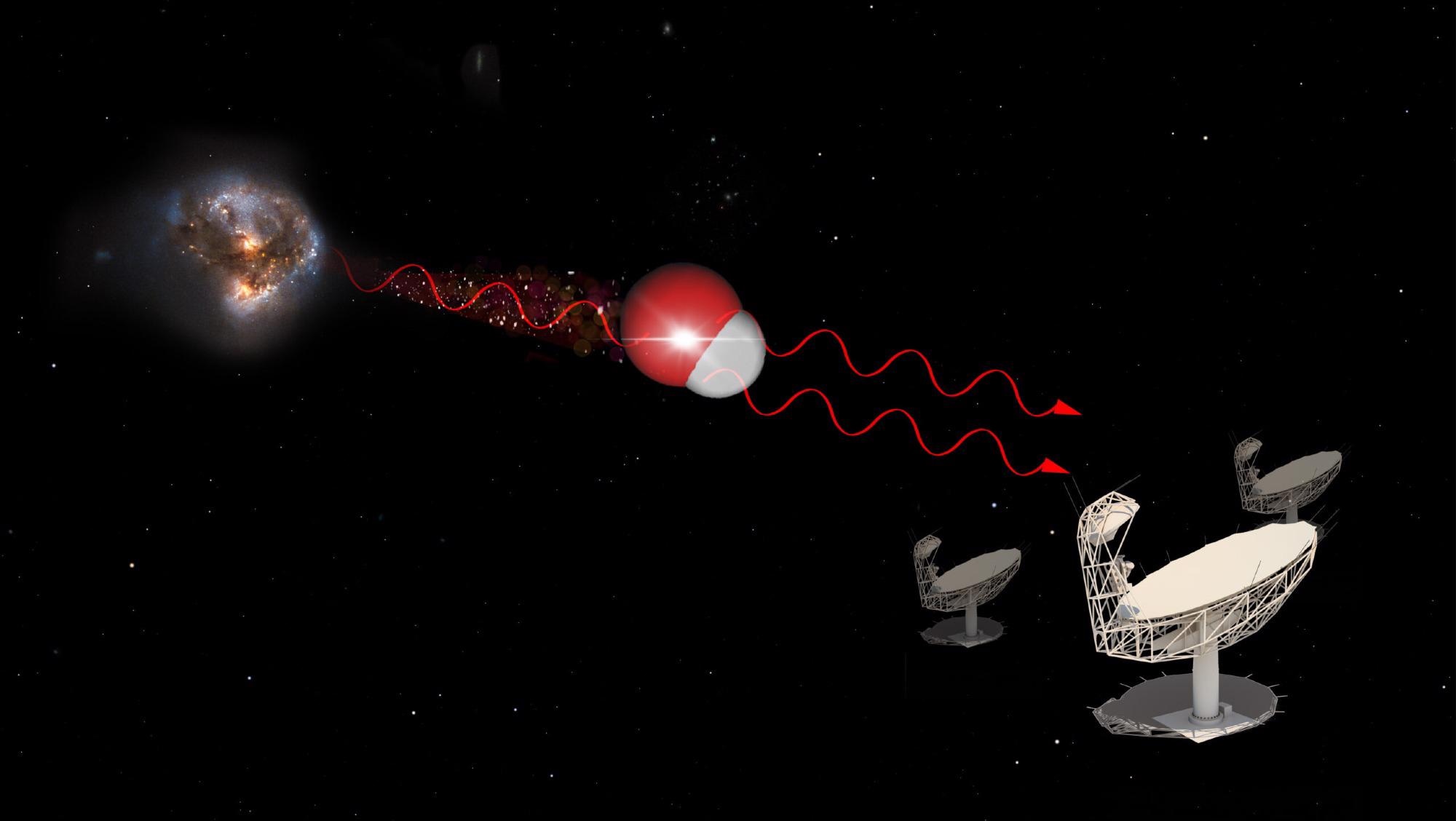Reviewed by Alex SmithApr 8 2022
The MeerKAT telescope in South Africa has discovered a strong radio-wave laser termed a “megamaser.”
 Artist’s impression of a hydroxyl maser. Inside a galaxy merger are hydroxyl molecules, composed of one atom of hydrogen and one atom of oxygen. When one molecule absorbs a photon at 18 cm wavelength, it emits two photons of the same wavelength. When molecular gas is very dense, typically when two galaxies merge, this emission gets very bright and can be detected by radio telescopes such as the MeerKAT. Image Credit: IDIA/LADUMA using data from NASA/StSci/SKAO/MolView.
Artist’s impression of a hydroxyl maser. Inside a galaxy merger are hydroxyl molecules, composed of one atom of hydrogen and one atom of oxygen. When one molecule absorbs a photon at 18 cm wavelength, it emits two photons of the same wavelength. When molecular gas is very dense, typically when two galaxies merge, this emission gets very bright and can be detected by radio telescopes such as the MeerKAT. Image Credit: IDIA/LADUMA using data from NASA/StSci/SKAO/MolView.
At nearly five billion light-years away from Earth, the record-breaking discovery is the most distant megamaser yet discovered.
The light from the megamaser has traveled 58 thousand billion kilometers to Earth (58 followed by 21 zeros).
Dr. Marcin Glowacki, who was formerly employed at the Inter-University Institute for Data-Intensive Astronomy and the University of the Western Cape in South Africa, led an international team of astronomers in making the finding.
Megamasers are normally formed when two galaxies collide violently in the Universe, according to Dr. Glowacki, who is currently stationed at the Curtin University node of the International Centre for Radio Astronomy Research (ICRAR) in Western Australia.
When galaxies collide, the gas they contain becomes extremely dense and can trigger concentrated beams of light to shoot out. This is the first hydroxyl megamaser of its kind to be observed by MeerKAT and the most distant seen by any telescope to date. It’s impressive that, with just a single night of observations, we’ve already found a record-breaking megamaser. It shows just how good the telescope is.
Dr. Marcin Glowacki, International Centre for Radio Astronomy Research, Curtin University
‘Nkalakatha’ [pronounced ng-kuh-la-kuh-tah]—an isiZulu term meaning “big boss” — was the name given to the record-breaking item.
The megamaser was discovered on the first night of a study comprising more than 3000 hours of observations by the MeerKAT telescope, according to Dr. Glowacki.
MeerKAT will be used to observe narrow parts of the sky in great detail and analyze atomic hydrogen in galaxies from the distant past to the present. Astronomers will be able to better comprehend how the Universe has developed through time by combining hydroxyl masers with hydrogen research.
We have follow-up observations of the megamaser planned and hope to make many more discoveries.
Dr. Marcin Glowacki, International Centre for Radio Astronomy Research, Curtin University
MeerKAT is a testing ground for the Square Kilometer Array, a global project to create the world’s biggest radio telescopes in Western Australia and South Africa.
Journal Reference:
Glowacki, M., et al. (2022) ‘LADUMA: Discovery of a luminous OH megamaser at z > 0.5’. The Astrophysical Journal Letters. doi.org/10.48550/arXiv.2204.02523.